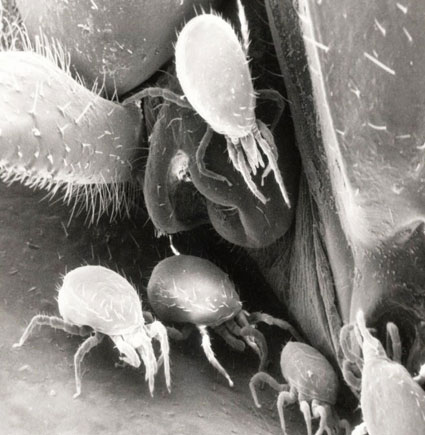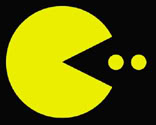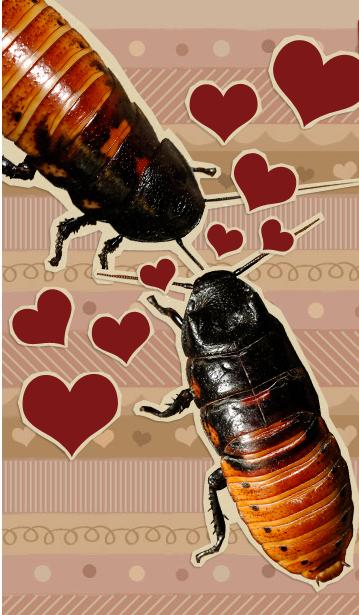





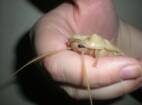
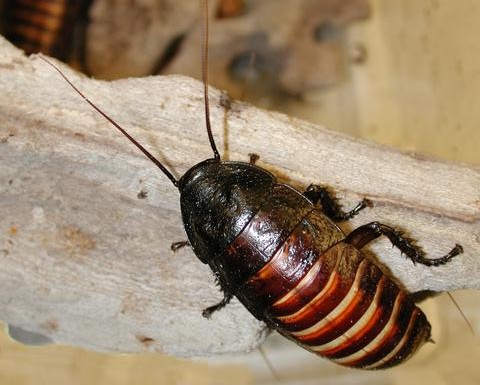
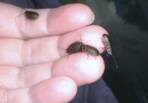

Madagascar Hissing Cockroaches
are a pretty unique pet just by
themselves, but there is some
pretty awesome and creepy stuff
about them. Hissers are movie
stars, models, mate makers, and
allergy-eating mite movers! What
else can these weird and wonderful
creepy crawlies do?!
Movie Stars!
Madagascar Hissing Cockroaches are often used in movies because they are large, handleable... and super creepy! Often they are shown living in garbage and filth, but that is not where Hissers really live. Their natural habitat is the forest floor in Madagascar. They do not live anywhere else. But that doesn't mean they aren't popular with Hollywood!
The following are movies that Hissers are in, but there are certainly more! (If you have a reference, shoot me an email and I will add it!)
featured prominantly as cockroaches who could
set fires by rubbing their legs together!
Good thing REAL Hissers can't do that, huh?
(1997 Rated R - Kids,
skip this one!) (on
imdb) A movie about a
war against an enemy
called "The Bugs," a
teacher is shown
encouraging her
students to step on
Hissers as part of a TV propaganda broadcast.
Team America: World Police (2004 Rated R - Kids,
DEFINITLEY skip this one!) (on imdb) MIB was later
parodied where one emerges from Kim Jong-il's body
after his death, enters a tiny spaceship, and flies away.
Madagascar Hissing Cockroaches have been featured repeatedly on the reality show Fear Factor.
Once, contestent Josh Shwadron had to lay in a coffin covered in 15,000 Hissers! That's probably 75 pounds of roaches!
Another time (Celebrity Fear Factor in 2001, season 3), celebrity magician Teller ATE roaches (though he is not the only one!)

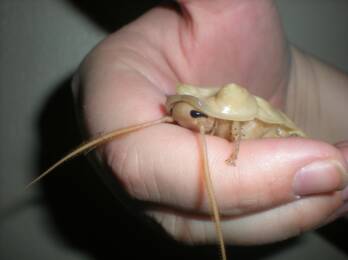
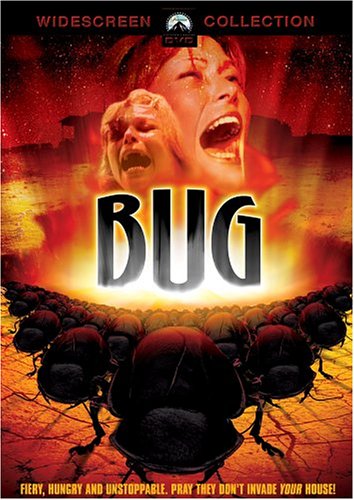







Fear Factor isn't the only show to use Hissers. Did you know that these bugs were LIVING JEWELRY on America's Top Model, Season 6? The episode is called "The Girl Who Kissed A Roach" and features the designs of Salt Lake local, Jared Gold! But more about that later in Models!
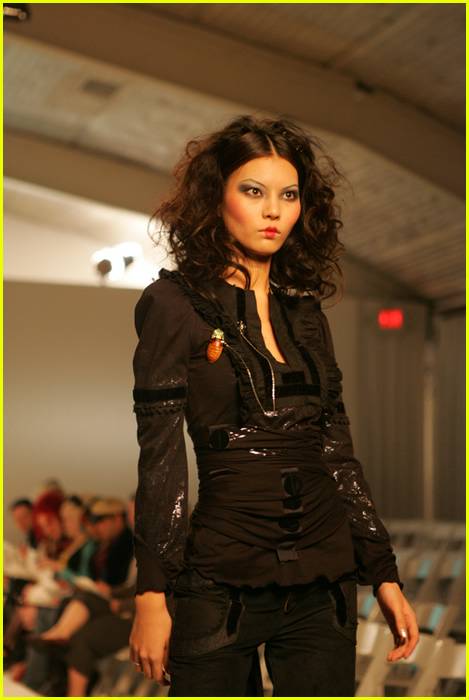
(If you choose to use real Hissers for "death scenes," that is your choice, but you will need to buy the roaches and do it yourself. I can't help you with that. But other than that, I am your girl!)
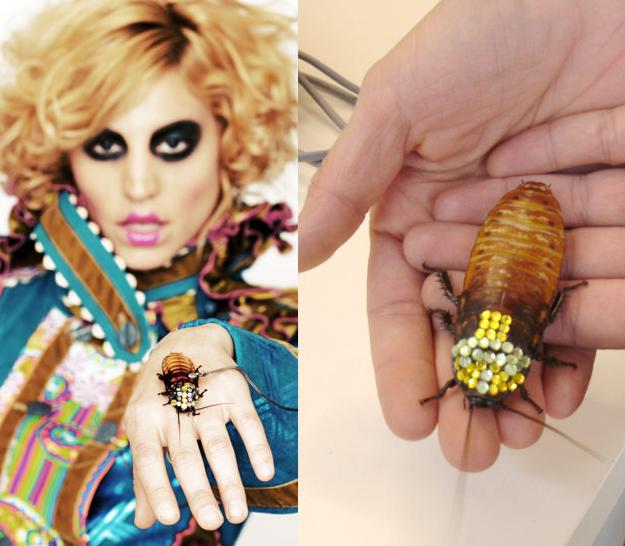
Models!
Did you know that America's Top Model, Season 6 "The Girl Who Kissed A Roach" featured the designs of Salt Lake local, Jared
Madagascar hissing cockroaches hiss when they feel threatened or discomfort, thus our roach jewelers hand select only the roaches who enjoy being handled and are completely compliant during the jewelling process. During jewelling, which involves affixing jewels to the exoskeleton of the roach, a small metal loop is also attached allowing you to clip your roach to a pin and chain that doubles as a brooch and leash for your fancy friend.
Important notes: Our Roaches, Gromphadorhina portentosa, are live creatures who require proper care to be in tip top shape to accompany you to all tomorrow's parties. With the purchase of your Roach Brooch you will also need to provide it a place to live, we recommend a small to medium terrarium with a place to hide and rest, along with a damp sponge to absorb moisture and healthy snacks like fruits and veggies. Roaches l When we ship our roaches to you, we must make proper carriage for them to travel safely so shipping is not based entirely on weight in this case. We know you will fall in love with your new Roach friend. All we ask is for you to love them as much as we do!
The blog, Roach Brooch (may have some PG-13 language! Ask your parents before reading.) shows various celebrities sporting roaches with their fanciest wear! Their tag line is, "It's not a pest if it's pinned to your chest!" Now that's wild! Here is a like where the designer answers some questions to the Washington Post.
But Bejeweled Bugs seemed to have caught on with others as well. Because of this craze, I have had many customers ask HOW to bedazzle their Hissers. While I prefer my pets au naturale, I have decided to post instructions so that IF YOU ARE GOING TO DO IT, YOU DO IT HUMANLEY!
1. Make sure your Hisser is an adult, done molting.
2. ONLY bejewel the immovable "hood" part of the cockroach, so as not to impede movement.
3. Use a non-toxic BODY SAFE
glue, as you might use to glue
jewels onto your own skin or
nails.
4. Remember, just like the
Black Chandelier says, these
roaches are LIVING things.
Just because you glue things
on them doesn't give you an
excuse not to give them food,
If you must take up bedazzling bugs, just don't forget they are animals, not just accessories!!!
By the way, if you DO decorate your Hissers, take a picture! Send it to us and we might just put it here on our page! (the same goes for any awesome Hisser FAN ART you draw, color, etc.!)
Mate Makers? <3 (Give the One You Love... a ROACH!)
This last Valentine's Day (Feb 2012), the
Bronx Zoo (the one famous for the cobra
who escaped... and then started a
Twitter account) thought up a VERY
original gift for the one you love (and a
way to raise money for the Wildlife
Conservation Society to boot!)
According to this article at Geeks of
Doom:
Maybe they will do it
again next year? Oh
well. Maybe we will
have to try to sell
Valentine's gifts?
While we are at
Critters 2 Go are
STRONGLY against
Novelty Pets
(Rabbits, Chicks,
and Ducklings for
Easter, Puppies and
Kittens under the
Christmas tree,
Black Cats for
Halloween) (and
Hedgehogs for Hedgehog
Day???) because
ALL animals deserve
FOREVER
HOMES
that have DONE
THEIR HOMEWORK
before bringing them
home, we think
Hissers are one of
the more LOW maintenance pets out there (especially among EXOTICS!) and we have even advertised them as pretty awesome "creepy, cool stocking stuffers!" Maybe they would make a sweet Valentine... for a really QUIRKY sweetheart, anyway!
Allergy-Eating Mite Movers?!
Some people worry that having a cockroach as
a pet might make them sick. Well, not only have
studies shown that Hissers do not transmit illnesses to their human owners, but a study at Ohio State University shows that the mites that sometimes live on Hissers (and ONLY Hissers) can actually reduce allergies of people who handle the roaches! Whoa!
Here is an article from National Geographic!
Mites on Hissing Cockroach May Benefit Humans With Allergies
By David Braun of National Geographic
April 29, 2009
Picture of mites on a Madagascar hissing
cockroach is courtesy of Ohio State
University.
Mites living on Madagascar hissing
cockroaches help decrease the presence
of a variety of molds on the cockroaches’
bodies, potentially reducing allergic
responses among humans who handle the
popular insects, according to Ohio State
University.
Scientists cultured and identified fungi on
the cockroaches’ body surfaces with and
without mites and discovered that the
presence of these mites reduced the
molds by at least 50 percent, the
university said in a news release today.
“Many of these same researchers reported
a year ago that 14 different types of mold
were present on and around this species
of cockroach, including several fungi associated with allergies and others that can cause secondary infections if they enter the lungs or an open wound,” the release said.
The mites eat saliva and organic debris that collects between the cockroaches’ legs, eliminating material that would foster mold growth on the insects’ bodies. The mites don’t appear to actually eat any mold.
“We haven’t proved yet that this helps the cockroaches, but reducing the fungi present on their surface is beneficial overall,” said Joshua Benoit, a doctoral student in entomology at Ohio State and a co-author of the study. “By suppressing the molds, the mites have a role in reducing allergic reactions to cockroaches.”
The research is published in the current issue of the journal Symbiosis.
The Madagascar hissing cockroach, or Gromphadorhina portentosa, grows to between 2 and 3 inches long and 1 inch wide, and makes its characteristic hissing sound if it is squeezed or otherwise feels threatened, the news release said. “Its gentle nature, large size, odd sounds and low-maintenance care have made the species a popular educational tool and pet for years.”
When Benoit and colleagues discovered the molds on cockroach surfaces in a previous study, they recommended that people wash their hands after handling the cockroaches and emphasized the need to keep the insects’ cages clean. Because the mites do not completely eliminate fungi, the researchers continue to recommend that people sensitive to molds use care in handling Madagascar hissing cockroaches.
“It turns out that not all colonies of Madagascar hissing cockroaches harbor the mites, a species called Gromphadorholaelaps schaeferi. Researchers do not know why that is,” the release said. “But the cockroaches that do harbor mites also harbor fewer molds on their bodies.”
In the study, female cockroaches with mites had 64 percent fewer fungal colonies than those lacking mites. In males, the difference was 31 percent, and in nymphs, or younger and smaller cockroaches, there were 24 percent fewer fungi.
“The presence of the mites caused a reduction in all fungi on the surface, not just a select few kinds of fungus,” said Jay Yoder, a professor of biology at Wittenberg University and lead author of the study.
About 20 to 25 mites live on each adult cockroach. The scientists experimented by adding more mites to the insects’ surfaces, but found that more mites didn’t result in a more significant reduction in molds.
“The number on each insect is based on the food available,” Benoit said.
In captivity, Madagascar hissing cockroaches thrive on dog food and fruit. Benoit said they tend to slobber on themselves when they eat, leaving saliva and organic debris in crevices along the lower middle portions of their bodies for the mites to eat. The mites are in particular need of the moisture in the food–meaning they eat up water and nutrients that molds need to establish themselves and grow.
“The mites also obtain moisture from spiracles through which the cockroaches breathe,” the release added. “The mites cannot live anywhere else but on the surface of the Madagascar hissing cockroach. Chemical cues from growing nymphs offer signals that a new host is large enough to house a colony of mites. When a host cockroach dies, the mites wander aimlessly on the carcass until they die, too.”
WOW!
More weird stuff to come! Check back later (and let us know if YOU have stuff to add!)
